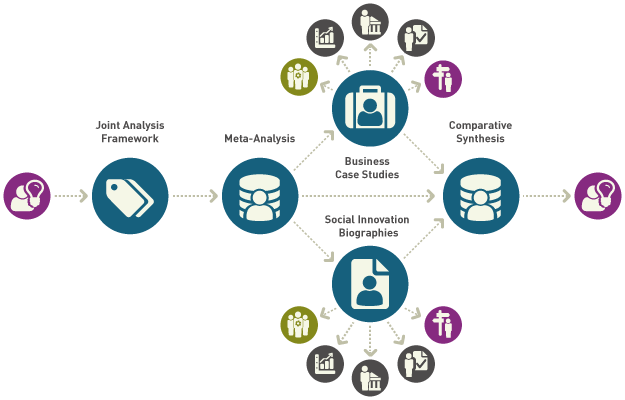COLLECTING EVIDENCE - Overview
Background
The need to substantiate policy and practice by evidence is a yet emerging theme in social innovation. Although a growing body of examples of successful and less successful social innovations exists, these are rather scattered and cover a multiplicity of divers aspects. Successful social innovations are economically effective, i.e., they are broadly accepted, reach a critical mass, are efficiently delivered and generate social return. Moreover, successful social innovation necessitates the interplay of «effective demand» and «effective supply».
To identify what works, how and why for economically successful innovations, it is necessary to gain detailed insights into the processes of social innovation throughout the lifecycle. This is what the second building block of SIMPACT concept focuses on by systematically collecting data and analysing them in a comprehensive way. Different levels of abstraction and thematic areas provide evidence and underpin the theoretical foundation of social innovation
Objectives
The overall goal is to provide evidence-based knowledge on the economic factors identified in WP1 including social innovation processes, components and their interplay based on qualitative research taking stock of existing social innovation case study databases as well as fieldwork to advance the understanding of the economic dimension of social innovation.
Methodology
Go to Meta-analysis of existing SIMeta-analysis of existing successful and less successful social innovation cases will be combined with social innovation Go to Business Case Analysisbusiness case analysis and Go to Social Innovtion Biographiessocial innovation biographies. On the one hand, this allows taking stock of the large pool of existing social innovations, prior research (e.g. TEPSIE, LIPSE, WILCO) and related policy initiatives (e.g. SIE). On the other hand, such procedure ensures the breadth and depth of findings.

The broad meta-analysis of existing cases, which captures multifaceted aspects of social innovation, is substantiated by in-depth analysis of specific economic factors. By following such an integrated approach - from general meta-analysis to more concrete and determined levels of specific social innovation processes and business models - SIMPACT provides evidence-based knowledge.
Basic Information
-
Coordinator
NEOMA -
Contact
Sharam ALIJANI -
Involved Partners
IAT, TUDO, CIS, UM-MERIT, POLIMI, NORD, UEF -
Start Date
07/2014
Latest News

August 22, 2015
SIMPACT publishes its «Comparative Report on Social Innovation across Europe», which summarises the findings of 60 social innovation cases for which Business Case Studies and Social Innovation Biographies were conducted.

August 1, 2015
SIMPACT publishes the findings on meta-component, meta-objectives and meta-princripples across distinct welfare regimes derived from the meta-analysis of 94 social innovation cases collected from existing databases.
Glossary
- 1
Meta-Analysis
A systematic analysis in which the researcher compiles numerous previously published studies (here: social innovation cases) on a particular research question (e.g. economic principles, objectives and components) and re-analyses the results to find the general trend or patterns for results across the studies.
- 2
Qualitative Comparative Analysis (QCA)
QCA provides a bridge between qualitative and quantitative research, integrating features of «case-oriented» and «variable-oriented approaches». It conceptualises cases as combinations of attributes and uses Boolean algebra to derive simplified expressions of combinations that lead to a specific outcome.
- 3
Business Case Studies
A descriptive, exploratory or explanatory analysis of a case (e.g. business) to explore causation in order to identify underlying principles, objectives and components.
- 4
Social Innovation Biographies (SIB's)
SIB's allow for the reconstruction of social innovation from its idea to scaling and diffusion identifying involved actors, processes and networks as well as their interplay plus related economic principles, objectives and components appyling narrative interviewing methods and triangulation.












